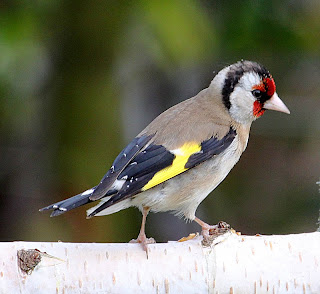They do say that a change is as good as a rest so Will and I experimented in catching House Sparrows this morning. Will was asked by an agricultural supply company at Brock, near Garstang, if anything could be done about the numbers of House Sparrows that invade the warehouse and target spilt animal feed, despite all sorts of safeguards to keep them out of the building. The problem is twofold, one of droppings contaminating the sacks that are later handled by staff and/or customers, but also that birds within the building often set off overnight burglar alarms necessitating a call out by the police to a member of staff or the manager.
So knowing how House Sparrows are quick to learn, notoriously difficult to fool and clever at avoiding efforts to catch them, we thought that mist netting a number of them in the act of leaving or entering the building might be:
a). A good PR exercise for ringing
b). An opportunity to ring some Red Listed birds and obtain a ring rebate from the BTO for doing so
c). A chance to pit our wits against those of a gang of House Sparrows.
So we set a single 20ft net against the sparrows’ favourite roller-shuttered entrance, went in through a separate entrance, lifted the door just enough to mist net height and waited for the sparrows to emerge into daylight.
 The Way In, The Way Out
The Way In, The Way Out House Sparrow
House Sparrow House Sparrow
House Sparrow House Sparrow
House SparrowThe end result was we caught 25 House Sparrows, 12 males, 9 females and 4 young of the year, plus 1 Blackbird.
A regular visitor into the warehouse is a male Sparrowhawk that chases the sparrows through the roof beams, often consuming its’ prey in warehouse or outside in the works compound where we set up base station. We didn’t see or catch the Sparrowhawk, but mid-morning an overhead Merlin heading west pursued by Swallows was compensation; and despite the urban nature of our ringing today we didn’t entirely lose out on birding with 2 Grey Wagtails, 1 Pied Wagtail, 4 Collared Dove and several Jackdaws, probably all waiting to drop into a favoured feeding spot.
We probably all take the humble House Sparrow for granted, and although declining in the UK it is common through most of its world range. It is tolerant of climatic changes and high mortality, provided that adequate food supply is always available. The populations have fluctuated greatly over the centuries, with a gradual decline over the last 100 years. Change from horse-drawn vehicles to motorised ones caused the House Sparrow population in many cities to drop by two thirds, with the removal of an important food supply - the cereal fed to horses. Recent declines have been caused by a combination of reduced plant food in winter, reduced insect availability for chicks, and reduction in available nest sites. On farmland, these are attributed to changes in agricultural practices. Housing of livestock in inaccessible buildings, mechanisation of grain harvest and more effective storage of grain and animal feeds all reduced the sparrows’ access to food. Recent cereal hygiene regulations mean that farm buildings are sealed, and therefore offer fewer nesting sites. In towns lack of food and nest sites are contributing to the decline, but there is not a full understanding of the House Sparrow's decline.
In the 1950s, the UK House Sparrow population was estimated at 9.5 million. They increased to 12 million by the early 1970s, then declined. The population crashed during the 1990s and over 25 years the population has declined by 62%. Because of this decline in numbers, the House Sparrow is now red listed as a species of high conservation concern.
An enjoyable morning to which we will return at some later autumn and winter dates, but tomorrow I need some warblers.















































































